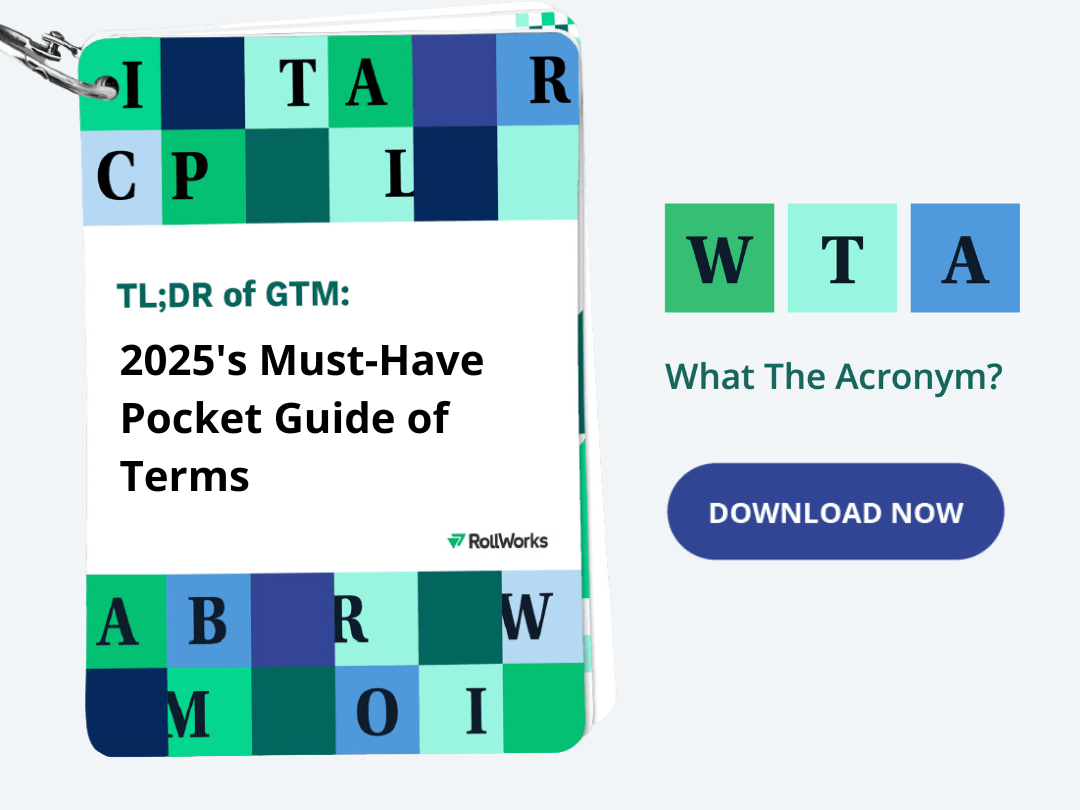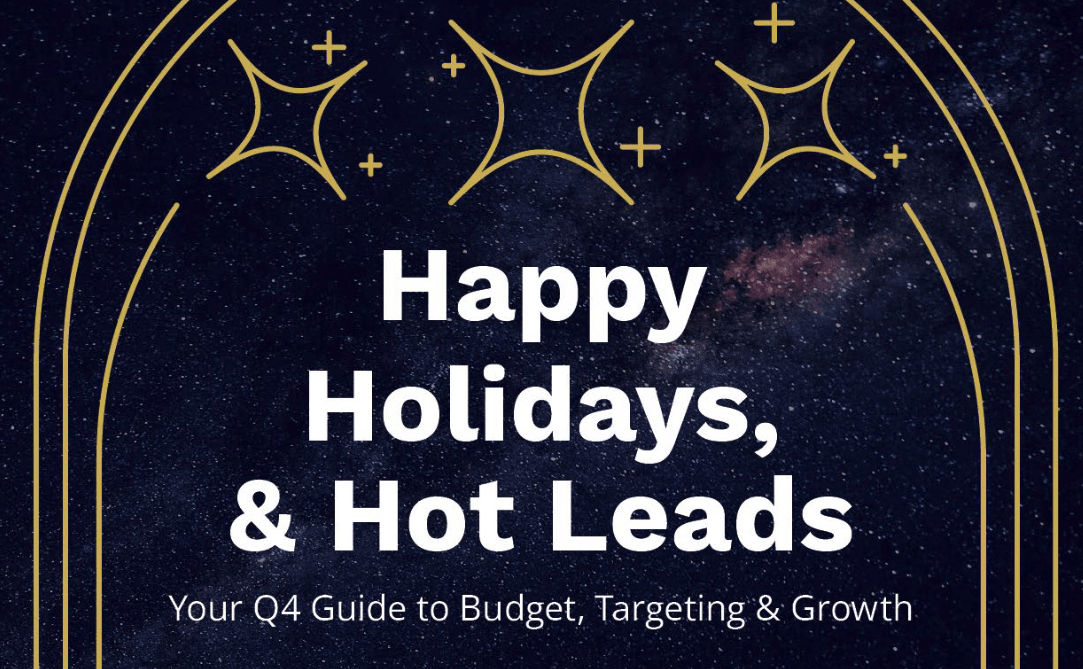First thing’s first…Sales Kick Off (SKO) has been through quite the evolution the past few years. Granted, just about every event has. What once was crowded conference rooms full of team building and information gathering is now a crowded Zoom window with your all-too-familiar reflection staring back at you (humans were not meant to see themselves so often, but that’s an opinion piece for another time.)
The only constant? Change (and buzzwords)
It may seem like everything has changed, but the truth is, some things haven’t — whether IRL or WFH. We’re talking about the reality of sitting through back to back sessions and hearing corporate speak for hours.
Don’t get us wrong, some of the best insights come out of SKO and no doubt it gets the team riled up to do big things in the new year (we’ll get to that shortly). But…that doesn’t mean you can’t have a little fun while the Zoom hours wane on.
Introducing: Your 2025 GTM Pocket Guide of Terms
Since those buzzwords haven’t lost their power over virtual events, it’s time to see just how many you hear (and can identify) during the course of your SKO.
Circle back? Check. Ideal Customer Profile (ICP)? You bet. This guide is here to help you get a handle on those hot topics and acronyms flying around.
Click to open the GTM Pocket Guide and keep it handy during your event. Check off each term or concept you hear, and see just how fast you can master the lingo that drives revenue in 2025.
The 8 questions sales will throw your way — and how to answer every time
While the GTM Pocket Guide of Terms keeps you on top of the latest buzzwords, you’ll be ready to field some burning questions sales will inevitably toss your way. Especially those 'buzzwords' that should never be removed from our lingo — ROI, ARR, pipeline, and the like.
As marketers, we hear about alignment with sales all the time, and this is a key moment to put advice into action. Showing that you’ve put extra thought into how your actions will impact their efforts, blindspots that you’ll address, and wins you’ll have together sets the stage for an unbeatable joint force in the new year. After all, that’s why there’s a growing trend toward calling it RKO (revenue kick off) rather than SKO — it takes the whole GTM function working together to create mega business impact.
Here are the topics you’ll want to be prep for, and how to answer them quickly and directly:
1. Sales qualified leads (SQLs)
Depending on your growth stage or business goals, SQLs can vary by specific definition — but no matter what, they mean one thing: quality. Your sales team needs to qualify whatever it is you're throwing their way, not just take it and run with it.
That's why more and more marketers are focusing on quality over quantity, also known as taking an account-based approach. Let your sales team know that you're not just running high-volume lead gen programs focusing on vanity metrics — tell them how you've identified your ICP (hopefully this was one together as it impacts other aspects of the business), built a list of accounts that are best fit for your business, and go about prioritizing campaigns against those targets.
Once you've done the work of qualifying accounts in advance WITH sellers, the contacts (or as many still call them, leads) that are ready to work are no-brainers. Feel free to add on any specific numbers or targets to show that you're still focused on outcomes, but they're no longer just lead volume — they're opportunity creation.
2. Real-time alerts for hot leads
This is a tried and true follow-up question once you've talked about the great campaigns you're launching (channels and offers galore)! While sellers get excited by this, they're more excited to know how they'll get insights into which contacts are most engaged.
Reminder: first let them know the quality of their 'leads' already were account-qualified, so real-time alerts are the hottest of the hot.
Put yourself in their shoes: you've got a laundry list of priorities each day, and deciding which account to pursue first or follow up with next can make or break that quota. Let them know you have their back and you won't just launch a campaign and let them scramble to see who's engaging, instead either provide regular reports or get them access to real-time alerts in their CRM.
What does this look like? Each day they'll come into the office with a ranked list of accounts by level of engagement, recency, content topics...all the goodies your sellers need to make smarter decisions.
3. Mind-blowing content
While your sales team must have storytelling capabilities (what's a pitch without it?), they don't own the burden of coming up with every bit of content that's going to wow their accounts. That's on marketing — and now's your time to shine.
Paint a picture of the top pain points your audience is facing, where they're getting their information, and what trends are driving their decisions. This is where calling on insights like intent data can build trust with your sales team — by tracking what your audience is surging on, you can create content that answers their burning questions throughout the entire buyer's journey.
From there, give them insight into the editorial calendar — what will be coming, when, and most importantly, what hooks they should use to follow up.
4. Brand awareness
As we've coined, no deal was ever won from an account that wasn't aware of your brand. It all has to start with awareness. Your sales team is likely selling in a super competitive market, where other brands are competing for limited eyes and ears.
With a mix of earned and paid efforts, you can strike the balance your team is looking for — press, analyst mentions, bylines, advertising, events...you get the picture.
An extra hot tip that will perk up the ears of any seller? By running always-on display advertising campaigns to key segments, all other channels see a lift in engagement — including SDR open rates.
5. Access to the marketing calendar
A key lesson that's been said time and time again — talk is cheap. While you can come to SKO with your best intentions and fully baked plans, make sure there's a place to follow through. Sellers have to make a handful of tiny decisions day-to-day, leaving them little extra time to go looking for information.
Whether it's a project management tool or something as simple as a google calendar, make sure your team knows what's launching, when.
An extra tip? Don't be shy to make this a key element of your meetings — the more you repeat, the more they retain. It also will give them a voice in the process, making way for feedback that may just make or break a deal (or two or three).
6. Collaboration
Shocker: a marketing calendar won't be the ultimate solution for collaboration. There's so much more to it! Ideally you've already met with your key sales counterparts (CMO-->VP Sales, Head of DG-->Head of Sales Dev, DG Managers-->Sales Managers..you get the gist) to get a game plan for how your independent and shared goals will come together.
A simple way to get started is to establish meeting cadences, clear agendas, mutual dashboards, preferred communication styles, and the biggest one, sharing results and next steps.
If you need a little refresher on this and a deeper dive, check out the pillars of alignment to take your collaboration from basic to best.
7. Insight into the competition
This will always come up at SKO — if anything, I'd consider it a hefty side dish on the plate of any conversation.
As the market's shown, the demand for product marketers has skyrocketed — and insight into competition is one of them. Make sure you're addressing this question outside of competing marketing campaigns or a recent billboard. Dive into pricing & packaging, areas of opportunity, and above all — arm them with information they need to cover common objections.
Consider create campaigns where you can pepper intent data around competitive search and launch targeted campaigns to woo prospects back your direction. Show that you're going to take action to support them.
At the end of the day, this topic could go thousands of directions. Keep it focused on how you're helping your sales team win more deals, and how they can make their jobs easier each day.
8. Ability to create urgency
The elephant in every room (or Zoom?) is that sales can naturally fluctuate, but the added element of a pandemic and constant economic ups/downs can cause lots of prospects to act erratically. Add the great resignation on top of it all, and things get even tougher as emails bounce or empty headcount looms (hello, darkness our old friend).
Assure your sales team that you're very well aware deals may be getting pushed back or prospects feel overwhelmed — give them a gameplan. Whether it's content addressing key objections or concerns, promos that alleviate a particular need, pivoting the value prop of features...show you're on top of it.
After all, you're there to create that demand and help them capture and close it.
SKO get ‘em
There you have it — a little fun and a lot of fuel to make this your best SKO yet. If you want to get started on a better foot with your sales team in 2025, check out our DIY checklist to go from basic alignment to the best alignment.
About the Author
Follow on Linkedin






























